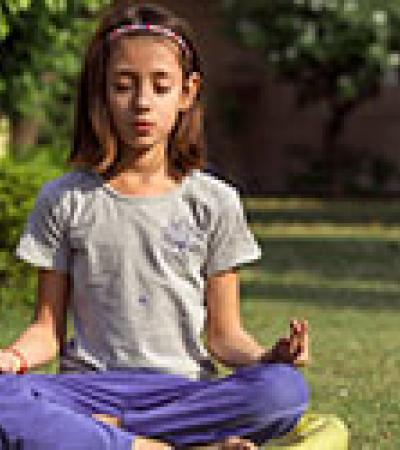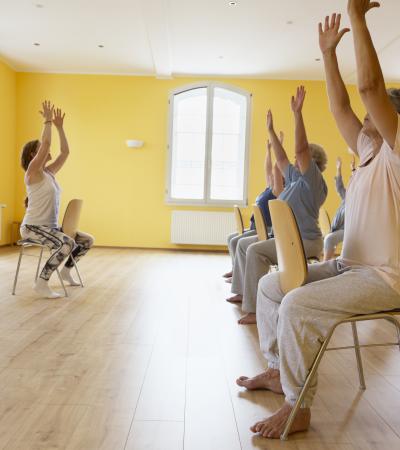I developed a mindfulness story time curriculum during the early months of the COVID-19 pandemic, drawing from my own experience using yoga as a coping mechanism, and based on my work as a children’s librarian.
I knew we were seeing unprecedented levels of stress among children, and while mindfulness webinars proliferated for staff and working adults, I wanted to think about ways in which I could bring concepts of mindfulness to existing children’s programming.
Mindfulness Story Time was featured at ALA's 2022 LibLearnX The Library Learning Experience, a conference of innovative and participatory education programs to help teach, network, and find solutions.
Advanced Planning
I had been practicing yoga for about a year regularly, and that did help my planning process, but I was by no means a trained yoga teacher. I took part in a low-cost webinar from Little Flower Yoga and read their book, and then developed my mindfulness program based on their five-part model: Connect, Breathe, Move, Focus, Relax. I built each story time around this structure, and after talking with my programming coordinator, decided to develop a six-part series. Each could stand alone but would be different enough to serve people who attended all six.
Due to the pandemic, and systems in place within my public library system, we planned for this to be streamed live on Facebook Live. I selected books that both explicitly mentioned mindfulness and that demonstrated it in other ways, and chose yoga poses that were simple and likely familiar to some children.
For each story time, I picked a book, a breathing exercise, and a yoga pose to teach:
- Week 1: Hot Chocolate Breath, Tabletop Pose - Mindful Monkey Happy Panda by Lauren Alderfer
- Week 2: Belly Breath, Child’s Pose - Yoga Bunny by Brian Russo
- Week 3: Finger Breathing, Downward Facing Down - Saturday by Oge Mora
- Week 4: Lion’s Breath, Upward Facing Dog - Carmela Full of Wishes by Matt de la Peña
- Week 5: Breathing Ball, Tree Pose - Gus is a Tree by Claire Babin
- Week 6: 3 Part Breath, Butterfly pose - Meditate with Me by Mariam Gates
Marketing
To promote this program, I created flyers in Canva to be shared with branches that were open to the public, and we made events on the library website to indicate when they would stream live. We chose to set a time each week to do it, Friday afternoons, to reach a school-aged audience, rather than the usual under-five story time crowd.
I included a flyer for this program in the school-aged take-and-make kits I was giving out in the weeks leading up to the event.
The way we schedule our Facebook events, they are advertised to the followers of our Facebook page up to a week in advance. This allowed people to “follow” and get an alert when the live stream began.
Budgeting
This was an entirely free program to put together and execute, but funding could be used to support training for staff through Little Flower Yoga, a meditation studio nearby, or to purchase books related to mindfulness that were not already in the program.
A yoga mat would be nice to have for each participant if this is an in-person event, but is not necessary.
Day-of-event Activity
We started each story time on Facebook Live by introducing ourselves and the program. We talked briefly about what mindfulness is — being intentional, slowing down, and paying attention to our bodies and our feelings. Then, I went over the outline for the story time: connect, breathe, move, focus, relax.
I taught our breathing exercise, and went through it a few times, and then the yoga pose, which we held for about 45 to 70 seconds. Then, I read each selected book (focus) and talked briefly about the tenets of mindfulness with that book, and how we can relate it to daily life. We ended each story time with a savasana, rest, for 15 breaths.
Most of these story times were live from the library, where I was able to use a conference room to demonstrate the poses. Having room to stand, sit, and move around was crucial to the poses and breathing exercise. For one of the story times that took place on a holiday, I filmed from home, and used a yoga mat, which worked well, though my cat did make an appearance.
Program Execution
We streamed to Facebook Live using StreamYard. My system of 26 branches has one account that is used between us all, and access is controlled. I had another staff member who acted as “moderator” of the chat and the stream while I lead the story time, and we both were well-versed in StreamYard beforehand. We pre-loaded the event — making it a “future event” on Facebook — into StreamYard seven days in advance of each session.
Advice
Wear comfortable pants, even if the yoga pose doesn’t require full-body motion. Practice in the setting you will use to ensure that the computer or camera is in the right place to capture the whole experience. No one wants to watch only your shoulders do upward dog pose.
You can watch my story times on the DC Library Facebook page. See sessions one, two, three, four, five and six here.


